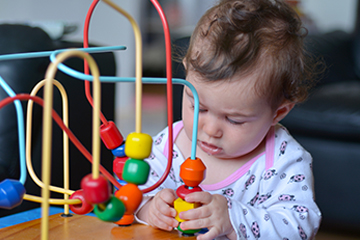Hand-eye coordination is one of the most important parts of the learning process and is integral to many everyday tasks, from reading and writing to using the computer and even tying your shoelaces. You may not think much about it, but the processes involved in coordinating your visual perception (to direct attention) and hand/arm movements (to execute a task) are actually pretty complex. Given this, it makes sense that hand-eye coordination is one of the first motor skills that babies learn and is especially important for child development and academic success, but is also an important skill that helps adults in countless activities on a daily basis.

As with any other type of skill, practice makes perfect. Helping your child to improve their hand-eye coordination is something to be encouraged and can begin from as early as four-five months. Play forms an essential part of the process through which children develop their hand-eye coordination. Honing your child’s eye-hand abilities can also lead to a range of benefits that will last a lifetime, including increased sports prowess, and may even help to prevent cognitive decline in old age.
In this article, we look at some of the ways to do just that, broken up into different childhood ages and stages. Many of these activities are surprisingly easy and fun to integrate into your child’s routine, so why not take a look and see if anything appeals to you.
Babies
Play and puzzles lie at the heart of learning good eye-hand coordination, especially for babies, who have not yet developed the ability to take verbal instructions or use complex reasoning. Activities such as these are all excellent ways of developing the hand-eye coordination of babies:
- Hanging a mobile over their crib or play mat
- Holding out toys in front of them
- Encouraging them to play with toys that emit sounds, such as a wrist rattle
- Using complex toys made up of different shapes, such as a set of keys
- Creating a block tower or toy stack they can knock down
It’s important to realize that this ability gradually builds up slowly over time. At first, most babies will display movements that seem random and reactive in nature like reaching out to grab a toy or waving their arms in the air. However, as they grow, these gestures will become a lot more focused and purposeful.
Toddlers
Once children reach toddler age, they should have a much better grasp of skills such as spacial awareness which plays an integral role in hand-eye based tasks like manipulating small objects or using things like crayons or eating utensils. Great ways to encourage further development of these skills include:
- Crafts that involve stringing beads, pasta threading etc.
- Finger painting and coloring-in
- Ball games like throw and catch
- Connect-the-dot activities
- Playing skittles.
All of these tasks involve a degree of purposeful movement, whether it be coloring within the lines or throwing a ball towards a specific place or person. Developing proficiency in these areas should result in an improved ability in your child to draw and write, eat and dress themselves, and manipulate objects more skillfully and easily.
Children of Five Years and Over
Children of five plus years usually have much more advanced motor skills, allowing them to play sports and engage in more complex forms of physical exercise. However, hand-eye coordination can always be honed and improved. Some excellent and fun ways to do so include:
- Building games like Lego, Jenga, Mechano and jigsaws
- Physical activities that involve balancing, juggling or a mixture of different catching/throwing techniques
- Crafts that involve using the hands to manipulate objects such as pencils, scissors, paintbrushes etc.
- Sewing/knitting/crocheting
- Playing musical instruments
These types of activities not only enhance concentration and help children to develop their problem-solving and task planning abilities, but they also strengthen the hand muscles needed for object manipulation and prepares them for key skills they will learn such as positioning a pencil/pen to write and draw; using scissors, holding a fork and knife, positioning buttons, zippers and laces for dressing.

No comments yet.